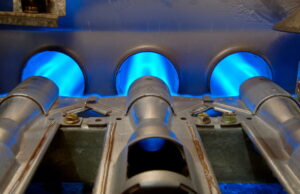
The answer to this question is: Maybe, but not in the way you think.
Such an answer obviously requires an explanation, and that’s why we’re here. We’ll get to the bottom of the old adage about gas furnaces drying out a home’s air. There’s some truth to it, but it isn’t for the reasons you might think, nor does it apply to all gas furnaces.
Below, we’ll reveal the truth behind gas furnaces and dry air in a house.
The action of a gas furnace doesn’t dry the air
This is the first thing to understand: the actual gas flames warming the air do not make the air moving through the furnace drier by removing moisture. That would be a serious negative, because it would mean water moisture condensing along the heat exchanger, leading to rust. The gas furnace isn’t sending out condensate water the way an air conditioner does. In fact, warmer air can hold more moisture. It’s the cold air of winter that holds less moisture, but you’re trying to keep that air outside.
And this is what leads to the real cause of dry air…
Some gas furnaces create air deficits in homes
A gas furnace that has its combustion chamber open to air (this is called an atmospheric combustion) draws on the air required for combustion directly from the space around it (i.e. from the house). If you can look inside your furnace and see the blue glow of the burners, then it uses atmospheric combustion.
When the furnace draws on indoor air for combustion, it creates an air deficit for the house. This causes a movement of air from outdoors to the inside. Because this air is colder, it is also drier, and the house’s humidity level will decline. This is the reason people attribute drier indoor air to the gas furnace—but the drier air isn’t from the furnace, it’s from outside.
The sealed combustion furnace
Not all gas furnaces use atmospheric combustion. There are sealed combustion furnaces on the market today, which are usually part of high-efficiency furnaces. With sealed combustion, the combustion chamber is closed off from the house. The furnace instead draws the air necessary for combustion through a PVC pipe to the outside. This process creates no indoor air deficit and avoids outdoor air pouring in. It also helps to improve energy efficiency and is safer than standard furnaces.
Solving dry indoor air problems
If you are in the market for a new furnace, consider a sealed combustion model to help you with dry air issues in the house. However, you can also opt to have a whole-house humidifier installed to counteract low humidity indoors, whether due to the furnace or other sources.
You can rely on us to help with finding the best solution to your heating and indoor air quality concerns. Our team abides by the principle of honoring co-workers and customers and with integrity and character beyond reproach.
Michall Daimion Heating & Air Conditioning, Inc. has been The Main Line’s premier service provider since 1976. For heating repair in Phoenixville, PA or other heating services, call us today.
